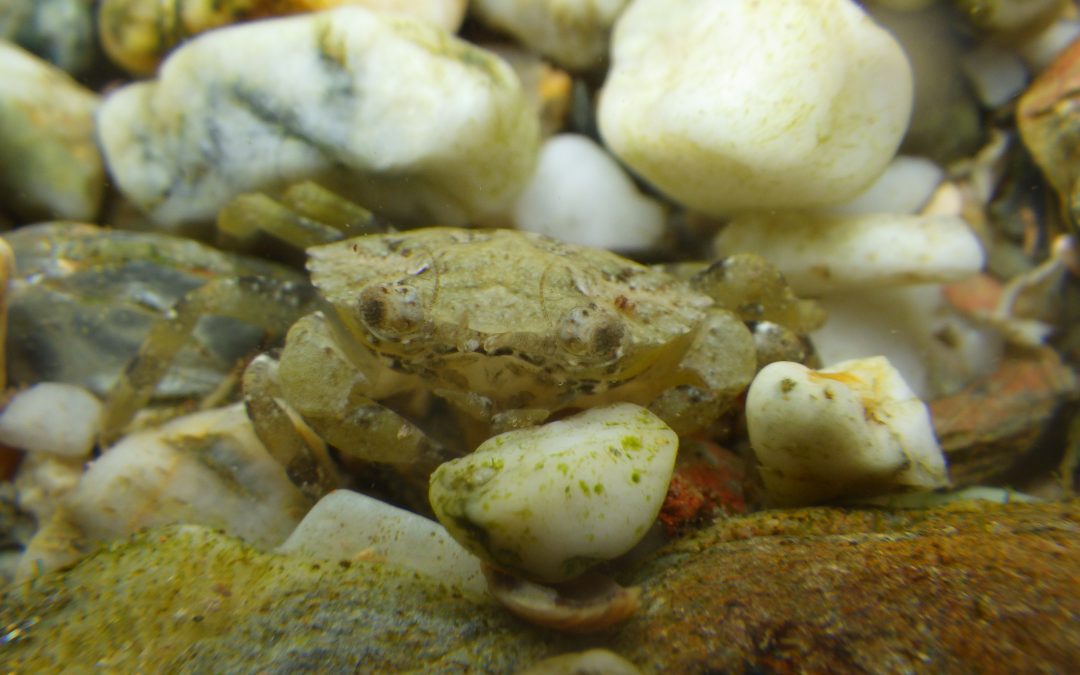Colour-changing crabs struggle to camouflage themselves when exposed to noise from ships, new research shows.
Today the marine environment is experiencing unprecedented levels of human-made (anthropogenic) noise, which scientists have shown impacts on organisms in a range of different, and oftentimes negative ways, affecting sensory systems and behaviours.
In a paper published today (March 9) in the journal Current Biology, University of Exeter scientists show that anthropogenic noise—in their study from shipping— reduces colour change and consequent camouflage in juvenile shore crabs (Carcinus maenas).
The scientists find also that the noise affects the crabs’ behaviour. Shore crabs, often found in rock pools, usually stay still or scuttle for cover if a predator approaches, but ship noise disrupted these abilities, negatively affecting their defensive responses, with crabs less likely to flee a simulated attack.
In contrast to human-made noise, ‘natural’ ocean sounds played as loudly as ship noise had no effect on crab camouflage or behaviour, the study found. According to the researchers, the study shows that anthropogenic noise is likely to be more disruptive than previously anticipated.
They state: “In common with other marine invertebrates, shore crabs may perceive sound, but they rely predominantly on other senses. As such, the effects of anthropogenic sound in the marine environment extend beyond interfering with acoustic communication, affecting behavioural and physiological responses across a wide range of species.”
Speaking of the study, lead author Emily Carter, who led the research as part of her MRes at Exeter’s Penryn Campus in Cornwall said, “Ship noise is a major source of underwater sound pollution. Previous studies have often focussed on how this affects species that rely on sound.
“Shore crabs don’t depend heavily on sound—so our finding that noise affects their behaviour and ability to camouflage themselves suggests ship noise might affect a very wide range of species.”
Professor Martin Stevens, of Exeter’s Sensory Ecology and Evolution group, added: “Our study shows that humans and noise pollution can substantially affect features of animals such as their colouration that are crucial to survival.
“If crabs are less well concealed, and less likely to run away, they are more likely to get eaten by predators.”
The study focussed on juvenile shore crabs, which change colour gradually and can make more dramatic changes when they moult (shedding their shell as they grow).
The crabs in the study were housed in one of three tanks, and were exposed either to quiet underwater sounds, an hourly recording of a ship passing (played to simulate the ship being about 200 metres away) or an hourly loud occurrence of underwater sounds.
The crabs were all dark-shelled at the start. After eight weeks in the white-bottomed tanks, all had become paler. However, those exposed to ship noise only changed around half as much as those in the other tanks, leaving them much less camouflaged.
When exposed to a predator (simulated by an artificial bird) more than 85% of crabs exposed to quiet or loud natural sounds responded by rushing for cover.
The crabs exposed to ship noise responded normally when the noise wasn’t being played – but during noise episodes, about half responded more slowly than usual and the other half didn’t respond at all.
“The size and strength of adult shore crabs mean they have other defences, but juveniles rely heavily on concealment and are attacked by many predators, from fish to birds—so a reduction in their camouflage ability and anti-predator behaviour could be a big problem,” said Carter.
“Previous studies have suggested that a lot of energy may be used during colour change, and stress is also thought to be costly in terms of energy.
“So, the most likely explanation for our findings is that the stress caused by ship noise means crab don’t have as much energy to devote to camouflage.”
Professor Tom Tregenza, of the University of Exeter, said: “We already knew that noise can be disruptive to marine animals, but a breakthrough from this study is to show that the racket ships make is much more disruptive than natural noise, even if the natural noise is equally loud.”
The paper, ‘Ship noise inhibits colour change, camouflage, and anti-predator behaviour in shore crabs’, is open access and can be found at https://doi.org/10.1016/j.cub.2020.01.014
Image credit: Emily Carter


Recent Comments